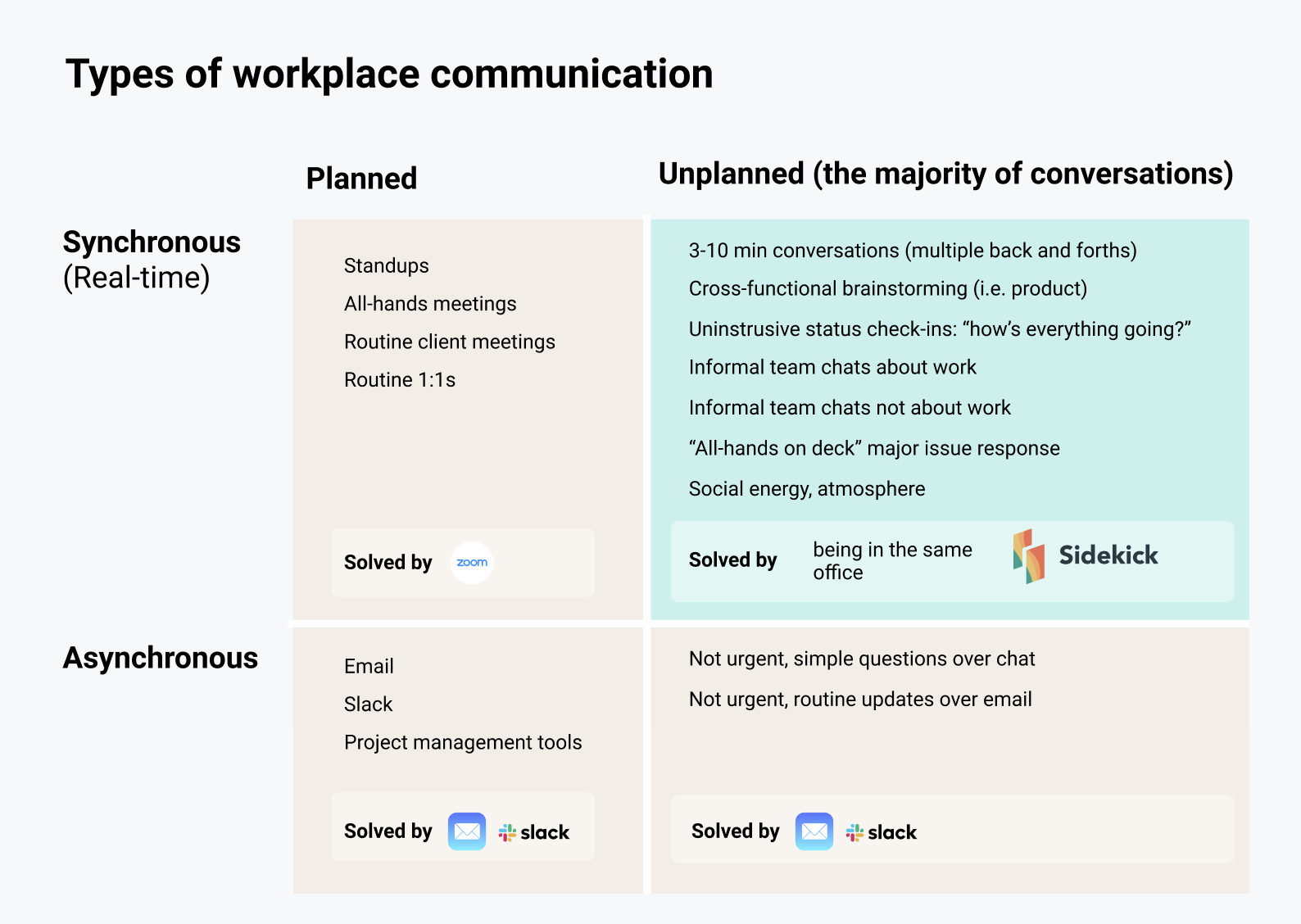July 10, 2020
Think about the best interactions you've ever had with the people you work with.
The ones where the best product ideas were born, that started with someone saying "I have an idea" in the middle of your desk area. The ones in front of the whiteboard, debating about the right design, that became the technical foundation for your entire company. The ones where your relationship subtly but surely turned from being mere colleagues to becoming trusted teammates, and sometimes even to becoming lifelong friends.
These interactions are the magic we've lost with the sudden shift to remote work caused by COVID. We are left only with a slog of blue tiles on our calendars — the scheduled daily standups, the precisely-1-hour long product meetings, and a scattering of 30-minute Zoom 1:1s. Our once fluid workdays have become Tetris tiles that fit together in only the most rigid of ways.
This new rigidity does not allow for those spontaneous deskside brainstorms, those multi-hour creative dives, or those deeper conversations that lead to trust and cohesion within a team. Both for the individual and for the business, these moments are some of the most damaging ones to lose.
At Sidekick, we interviewed over 100 world-class teams about their biggest struggles with remote work, and spontaneous connection and collaboration was almost always at the top of their lists.
We believe in remote work. We believe in personal freedom, in flexibility, in more time with family, in the ability to govern our own environment. But many would have you believe that the price for these amazing things is stripping away the deeper human connection with the people you work with — that everyday conversation can be replaced by shared to-do lists, by scheduled meetings, by chat apps, by more written documents, and by more and more process.
Our own experience ran so counter to this vision of work that we knew we had to build something new to change the trajectory of where we're headed.
We reflected deeply on what's needed to enable these organic conversations. We came from a background as ICs and managers working on distributed teams at Palantir and Google, where we had all the shiniest collaboration tools at our disposal — Slack, Zoom, Notion, Tandem. Despite this entire suite of shiny tools, we would still fly out for a week every month from our home office in NYC to join our remote halves in London — over 20 hours in travel and thousands of dollars in expenses every month. Yet those were always the best weeks — we shipped the fastest, we came up with great new ideas, we felt closest to our teammates. Those weeks were our secret sauce in building awesome products. Reflecting on this, it was clear that the current frontier of tools fell far short of the experience of actually sitting together in the same room.
So we asked ourselves — is it possible to bring that experience of working together in the same room to remote teams everywhere? We built an experimental new product in search of an answer, and gave it to a few teams in order to hold ourselves accountable to delivering the experience we set out to build.
What happened next was magical. Every one of these teams — newly remote due to COVID and struggling to find the right team dynamic — became fanatical users. Every team had 20 new conversations per day that they weren't having before; conversations ranging from simple "how are you"s to deep spontaneous creative sessions. They were so excited by this new capability that they told all their friends struggling with the same problem. Today marks 1 month since the day we shipped the product to our first team — there are now more than two dozen remote teams actively using the product every day to work together like they're in the same room again.
The product we built is called Sidekick. It's a new hardware device that connects remote teams with an background video call. It's exceedingly simple. It sits on your desk right next to your laptop and when you want to talk to your teammate you just look over and talk — just like real life.
Of course, running a background video call is not a new idea. In fact, almost all of the teams using Sidekick today have tried to implement an always-on Zoom call. It failed every time. Our users told us it failed for two reasons:
Within a week, the Zoom would break down entirely — people stopped joining because it was just too much friction and because their teammates weren't there.
We asked our users what made Sidekick better. They told us that the separate hardware device makes it natural and frictionless to start conversations, just like if their teammate was sitting next to them (no app management / window switching to interrupt their flow). They told us that they loved features like getting notified when teammates join, meeting mode that allows them to stay in the room even while taking a meeting on their laptop, and calendar integration to easily set expectations around when they'll be back. On average our users leave their Sidekick on for 6 hours a day — they turn it on first thing when they sit down in the morning and leave it on throughout all their meetings during the day.

We don't want to live in a world where we don't get to keep any of the deep human connections that make work meaningful and productive. Our mission is to ensure that those meaningful interactions stay, even as new patterns of work emerge due to the changing conditions of the world. We believe that in building Sidekick — a high-fidelity simulation of a physical team room — we've taken first steps in the right direction.
If this resonates, we'd love to hear from you. Contact us here.